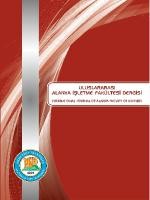Passenger Demand Prediction for Fast Ferries Based on Neural Network and Support Vector Machine
Passenger Demand Prediction for Fast Ferries Based on Neural Network and Support Vector Machine
-,
___
- CHOUDHRY, R., GARG, K., (2008), A hybrid machine learning system for stock market forecasting. World Academy of Science, Engineering and Technology, 39(3), 315-318.
- CORNELL UNIVERSITY, Cornell Department of Mathematics, Numbers Math Activities, Season:2 Episode:219,. Retrieved on July 2, 2015, available from World Wide Web: www.math.cornell.edu/~numb3rs/kostyuk/num219.htm.
- DTREG, Introduction to Support Vector Machine (SVM) Models. Retrieved on July 2, 2015, available from World Wide Web: https://www.dtreg.com/solution/view/20.
- ERDAL, H. I., KARAKURT, O. (2013), Advancing monthly streamflow prediction accuracy of CART models using ensemble learning paradigms, Journal of Hydrology, 477, 119-128.
- ERDAL, H., (2015), Contribution of machine learning methods to the construction industry: Prediction of compressive strength, Pamukkale Univ Muh Bilim Derg, 21 (3), 109-114.
- GÜLEZ, K., Yapay sinir ağlarının kontrol mühendisliğindeki uygulamaları. (Lecture notes, 2008) Yıldız Teknik University, Retrieved on July 2, 2015, available from World Wide Web: http://www.yildiz.edu.tr/~gulez/3k1n.pdf.
- GÜLLÜ, H., PALA, M., İYİSAN, R., (2007), Yapay sinir ağları ile en büyük yer ivmesinin tahmin edilmesi. Sixth National Conference on Earthquake Engineering, Istanbul, Turkey.
- İETT, İstanbul`da Toplu Taşıma, Retrieved on February 20, 2016, available from World Wide Web: http://www.iett.gov.tr/tr/main/pages/istanbulda-toplu-tasima/95
- İSTANBUL BÜYÜKŞEHİR BELEDİYESİ, (2014), 2013 Faaliyet Raporu. İstanbul, Mali Hizmetler Daire Başkanlığı, Strateji Geliştirme Müdürlüğü. Retrieved on March 15, 2015, available from World Wide Web: http://www.ibb.istanbul/tr-TR/BilgiHizmetleri/Yayinlar/FaaliyetRaporlari/Documents/2013/ibb_faaliyet_Raporu_pdf/ibb_faaliyetraporu2013.pdf
- KARAGÜLLE, F. (2008), Destek vektör makinelerini kullanarak yüz bulma (Master dissertation), Trakya University.
- ÖZER, K., (2009), İstanbul deniz otobüslerinin bir hattında yolcu talep tahmini (Master dissertation), Marmara University.
- PALMER, A., MONTANO, J. J., SESÉ, A., (2006), Designing an artificial neural network for forecasting tourism time series. Tourism Management, 27(5), 781-790.
- SMOLA, A., SCHÖLKOPF, B., MÜLLER, K. R. SMOLA, A., SCHÖLKOPF, B., MÜLLER, K. R., (1998), in Proceedings of the 8th International Conference on Artificial Neural Networks, 79-83.
- VAPNIK, V. N., CHERVONENKIS A., (1964), A note on one class of perceptrons. Automation and Remote Control, 25, 838-845.
- WEIGEND, A. S., HUBERMAN, B. A., RUMELHART, D. E., (1992), Predicting sunspots and exchange rates with connectionist networks. In Santa Fe Institute Studies in the Sciences of Complexity-Proceedings, 12, 395-395, Addison-Wesley Publishing Co.
- YUMURTACI AYDOGMUS, H., ERDAL, H. I., KARAKURT, O., NAMLI, E., TURKAN, Y. S., ERDAL, H., (2015), A comparative assessment of bagging ensemble models for modeling concrete slump flow, Computers and Concrete, 16, (5), 741-757.
- ISSN: 1309-1522
- Başlangıç: 2015
- Yayıncı: Akdeniz Üniversitesi
Kamu Çalışanlarının Örgütsel Güven Düzeyleri İle İş Motivasyon Araçları Arasındaki İlişki
Münire KARABEKİR, Abdülkadir AKÇAY, Bayram ÖZHASAR
Eray AKGUN, Celil ZURNACI, Mehmet MERT
Alanya Turizm Sektöründe Kümelenme ve Ağyapı Analizi
Hakan DEMİRGİL, Hidayet ÜNLÜ, Aykut SEZGİN, Onur SUNGUR, Murat DULUPÇU
Gözardı Edilen Bir İşletme Türü Olarak Üniversite Öğrenci Yurtlarının Profili
Seyhan ÇİLKOÇYİĞİT, Bilge ELİTAŞ, Mahmut İŞGÜVEN
Endüstriyel Pazarlarda Algılanan Riskin Marka Duyarlılığına Etkisi Üzerine Bir Araştırma
